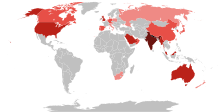
Summary
Nepali (also Nepalese; Nepali: नेपाली) are the citizens of Nepal under the provisions of Nepali nationality law. The term Nepali usually refers to the nationality, that is, to people with citizenship of Nepal, while the people without Nepales citizenship but with roots in Nepal such as Nepali Americans are strictly referred to as Nepali Speaking Foreigners (Nepali: नेपाली भाषी विदेशी) who are speakers of Nepali, Maithili or any of the other 128 Nepali languages but are now foreign citizens or of foreign nationality bearing passports and citizenship of the foreign nation. It is also not generally used to refer to non-citizen residents, dual citizens, and expatriates.[8]
नेपाली | |
|---|---|
 Map of the Nepali Diaspora in the World | |
| Total population | |
| c. 35,127,998 [citation needed] | |
| Regions with significant populations | |
| estimated 2,926,168 (2011 Census)[2] | |
| 700,000 (estimated)[citation needed] | |
| 405,069[citation needed] | |
| 406,917[3] | |
| 334,451[3] | |
| 200,385 | |
| 176,336 (2023)[4] | |
| 164,000 (2018)[5] | |
| 131,830 (2020)[6] | |
| 224,905[3] | |
| 71,193[3] | |
| 60,000 (2017)[7] | |
| 25,472[3] | |
| 21,975 (2021) | |
| 7,000[3] | |
| 17,057[3] | |
| 16,500[citation needed] | |
| 150,000[citation needed] | |
| 12,850[citation needed] | |
| 5,000[citation needed] | |
| Languages | |
| Nepali, Newar, Maithili, Magar, Tamang, Tharu, Gurung, Limbu, Rai, Sherpa, Doteli, Bhojpuri, Awadhi, Magahi, Bajjika, Angika, Hindi-Urdu and other languages | |
| Religion | |
| Hinduism (majority), Buddhism, Kirant, Prakriti, Islam, Christianity, Sikhism, Jainism, Bahai faith | |
| Related ethnic groups | |
| Nepali diaspora | |
Nepal is a multicultural and multi-ethnic country with a majority of Hindus (including Kirats and Buddhists) while Muslims and Christians of Hindu origin are minorities. Kathmandu Valley, in the middle hill region and the Madhesh Province, constitutes a small fraction of the nation's area but is the most densely populated, with almost 37 percent of the Nepali's population.[9][10]
Nepali diaspora edit
The Nepali diaspora or Non Resident Nepali are Nepali people living overseas.[11] The Non-resident Nepali Act, 2064 of Nepal defines a non-resident Nepali as someone who is a foreign citizen of NepaleseNepali origin including a NepaleseNepali citizen residing abroad.[8]
Province division of Nepal edit
Source article: Administrative divisions of Nepal
| province Number | Nick Names | Capital | Districts | Area(km2) |
|---|---|---|---|---|
| Province Number 1 | Koshi | Biratnagar | 14 | 25,905 |
| Province Number 2 | Madhesh | Janakpur | 8 | 9,661 |
| Province Number 3 | Bagmati | Hetauda | 13 | 20,300 |
| Province Number 4 | Gandaki | Pokhara | 11 | 21,504 |
| Province Number 5 | Lumbini | Deukhuri | 12 | 22,288 |
| Province Number 6 | Karnali | Birendranagar | 10 | 27,984 |
| Province Number 7 | Sudurpaschim | Godawari | 9 | 19,915 |
Notes:
- There are a total of 77 districts in Nepal Previously 75 but two districts were divided later on.
- Province No. 1 have maximum number of districts(i.e. 14) and province number 7 has the minimum number of districts
- Province number 6 has the greater land area coverage
See also edit
References edit
- ^ National Statistics Office (2021). National Population and Housing Census 2021, Caste/Ethnicity Report. Government of Nepal (Report).
- ^ Thapa, Deepak (28 January 2018). "Counting heads". The Kathmandu Post. Archived from the original on 14 July 2021. Retrieved 20 April 2020.
- ^ a b c d e f g "Migration in Nepal: A Country Profile 2019". International Organization for Migration. 18 December 2019. Archived from the original on 10 November 2021. Retrieved 10 November 2021.
- ^ 令和5年12月末現在における在留外国人数について
- ^ "Table 1.3: Overseas-born population in the United Kingdom, excluding some residents in communal establishments, by sex, by country of birth, January 2018 to December 2018". Office for National Statistics. 24 May 2019. Retrieved 19 April 2020. Figure given is the central estimate. See the source for 95% confidence intervals.
- ^ "Migration, Australia Statistics onAustralia's international migration". Australian Bureau of Statistics. Australian Bureau of Statistics. Archived from the original on 27 April 2021. Retrieved 27 April 2021.
- ^ "All empty everywhere: Nepali workers describe life in South Korea under Covid-19". The Kathmandu Post. Archived from the original on 3 March 2021. Retrieved 27 April 2021.
- ^ a b "Non-resident Nepali Act, 2064". Nepal Law Commission. Archived from the original on 10 November 2021. Retrieved 10 November 2021.
- ^ "National Population and Housing Census 2011" (PDF). Central Bureau of Statistics. November 2012. Archived from the original (PDF) on 31 July 2013.
- ^ "Nepalese peoples and nationality law". The World Factbook. CIA. Archived from the original on 9 January 2021. Retrieved 24 January 2021.
- ^ "Non Resident Nepali (NRN) ID". Embassy of Nepal, USA. Archived from the original on 10 November 2021. Retrieved 10 November 2021.


